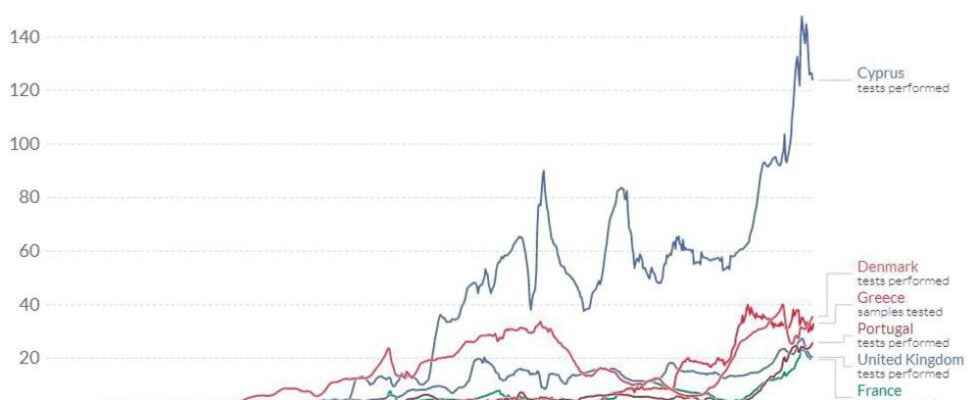On the health table, France flashes red. As of January 22, the weekly average of new cases recorded each day reached 356,906. Since the end of 2021, the number of contaminations in France has skyrocketed, fueled by the Omicron variant – more contagious and less pathogenic than its Delta predecessor. While a peak of infection was expected in mid-January, the curve of positive tests continues its vertical progression. A trend very different from that observed among its European neighbors. Starting with the United Kingdom, a country that used to serve as an indicator for the future. Across the Channel, the number of daily contaminations – on average over seven days – has been falling since the start of the year. As of January 22, it stands at 92,048, but the descent has slowed down for a few days.
For their part, Italy and Spain – affected by the Omicron wave – have reached their peak of infections. When we observe these data in relation to the population, only Denmark seems to be following the same path as France with respectively 45,864 contaminations per million inhabitants over one week against 37,403. Among the reasons given to explain the particularity French: massive screening initiated since the end of 2021: “Before the Omicron wave, we knew that only 50% of contaminations were detected. With the strong screening put in place, we recorded asymptomatic cases that we would not usually have detected”, estimates Jonathan Roux, epidemiologist at the School of Advanced Studies in Public Health in Rennes (EHESP). An argument taken up by the executive to justify the explosion of contamination. On January 3, the Minister of Health, Olivier Véran, had already affirmed on France Inter : “There is hardly any country that tests as much as we do.”
However, the figures recorded on Our World in Data qualify this assertion a little. A graph spotted on the database compares the number of daily tests per 1,000 inhabitants – over one week – in each country on January 21: Result: Cyprus comes first (123.81), ahead of Denmark (35.73) and Greece (33.12). France (19.44) is behind the United Kingdom (20) and Portugal (25.8). Thus, the strong screening at work in France is not enough to explain on its own the very high number of contaminations. To understand, we must focus on other political and health factors: the restrictions put in place, the epidemic situation or the question of vaccination. On this last point, Jonathan Roux notes “that vaccination was a little older in France during the fifth wave. People were not yet in the swing of the third dose.” Currently, 44.8% of the population has received their booster dose.
Covid-19: number of daily tests carried out by country per 1000 inhabitants (screenshot Our World in Data).
Our World in Data
Very different health strategies
Moreover, France has opted for a very different strategy by letting the Omicron variant circulate. While some European countries – such as the Netherlands and Germany – were put under a bell before the Christmas holidays, France has bet on a lighter arsenal of measures, the most emblematic remaining the adoption of the vaccine pass which made a lot of noise. “Among the range of measures available to us, we chose the least restrictive. The reason being that the Omicron variant is less dangerous”, continues Jonathan Roux. This is why the wave of contamination fueled by the new strain arrived earlier in France, while our neighbors could see it surge in the coming days. “In Germany, their methods of restrictions have brought down the Delta wave, but now they fear the arrival of an Omicron wave”, indicates Benjamin Davido, infectious disease specialist at Raymond-Poincaré hospital in Garches.
Indeed, if we look at the curve of contaminations in Germany, the latter is ascending: on January 23, there were 56,226 new infections against 33,129 on January 16. “In France the circulation of Omicron protected us from Delta”, underlines the specialist. After several weeks of cohabitation, the strain detected for the first time in South Africa has supplanted the Delta – 96% of contaminations are caused by the Omicron variant. In France, other elements have also been able to upset the forecasts established by the specialists. “It is possible that we are facing potential clusters in large cities. A scenario similar to that of the first wave”, continues the infectiologist. In particular, he envisages the possibility of a “mixture from east to west”. Last element that could shake up the trend: the Omicron sub-variant, also called the BA.2.
The strain has been identified in various countries, and particularly in Denmark, where it quickly became the majority.” In Denmark, we observe a first peak of contamination, then a second. The curve is a little choppy and that could be the effect of BA.2″, comments Benjamin Davido. The Danish authorities say they are closely monitoring the evolution of a sub-variant of Omicron whose characteristics are still unknown. On the French side, the Minister of Health declared that the “little brother of Omicron” did not “change the situation”, during the press conference given on Thursday January 20 after a Defense Council. To the infectiologist to conclude: “With a different penetration of the virus and public health policies acted at a moment T, the face of the epidemic changes completely from one country to another (…) we miss it a global health policy, at least on a European scale.”
